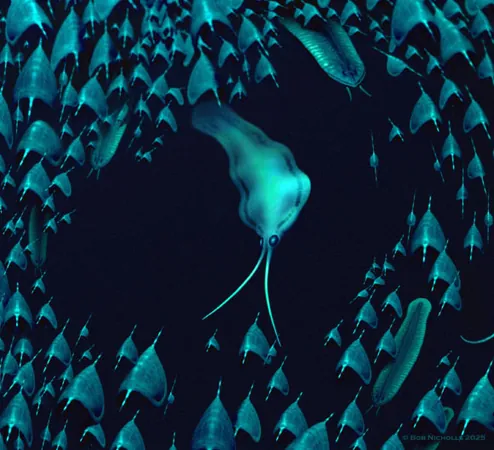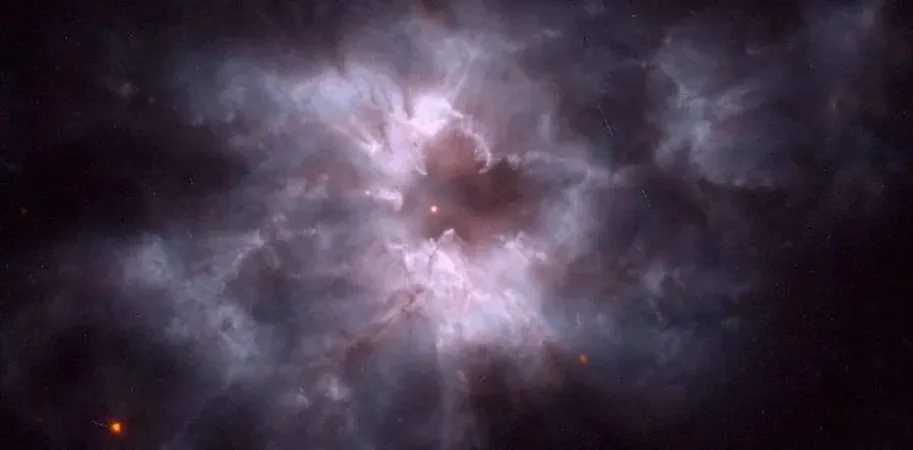
Ancient Swimming Predators: Nectocaridids Redefined as Early Relatives of Arrow Worms!
2025-07-24
Author: Arjun
Unlocking the Secrets of the Cambrian Sea
In a groundbreaking discovery, scientists have revealed that the mysterious nectocaridids, a group of enigmatic Paleozoic creatures, are actually early descendants of arrow worms, also known as chaetognaths. This revelation overturns previous theories about their classification and sheds light on their complex anatomy.
From Controversy to Clarity: The Nectocaridid Mystery
For years, researchers debated the origins of nectocaridids, previously affiliated with crustaceans, cephalopods, and even chordates. But an analysis of new fossils unearthed in North Greenland has changed everything, pointing to a lineage linked to the simple yet predatory arrow worms.
"Fifteen years ago, a study suggested they were cephalopods, but that didn't add up," remarked Jakob Vinther, a prominent paleontologist at the University of Bristol. His team's latest research provides compelling evidence to reconsider the old assumptions.
Meet Nektognathus evasmithae: A New Species Emerges
Among the fascinating finds is a new species, Nektognathus evasmithae, discovered in the 519-million-year-old Sirius Passet Lagerstätte. By examining 25 fossil specimens, the researchers were able to convincingly establish the position of nectocaridids on the evolutionary tree.
The Nervous System: A Key to Evolutionary Insights
The fossils revealed distinct paired mineralized structures of the nervous system, a significant clue. According to Dr. Tae-Yoon Park from the Korean Polar Institute, these features closely resemble those found in modern arrow worms, showcasing a profound link in their evolutionary journey.
The Ventral Ganglion: A Distinct Feature Uncovered
Another intriguing aspect of these fossils is the presence of the ventral ganglion, a unique nerve mass found in modern chaetognaths. Dr. Park noted that this distinctive structure solidified the connection between ancient nectocaridids and their contemporary relatives.
Complex Predators of the Past
Dr. Vinther described the unique camera-like eyes of these ancient swimmers, which contrast sharply with the simpler eyes of today’s arrow worms. "These ancestors were sophisticated predators in their time, much like squids, which evolved millions of years later," he explained. This suggests that ancient arrow worms held pivotal roles in their marine ecosystems.
Evidence of Carnivorous Behavior
Adding to the remarkable findings, researchers discovered several specimens with remnants of an ancient swimming arthropod, Isoxys, in their digestive tracts, reinforcing the idea that nectocaridids were active hunters.
A Study That Shakes the Foundation of Marine Evolution
This intriguing research was published in the journal *Science Advances*, ushering in a new understanding of both nectocaridids and the early ocean dynamics. With their combination of advanced anatomical features and predatory habits, these ancient creatures redefine our perspective on the evolutionary history of marine life.



 Brasil (PT)
Brasil (PT)
 Canada (EN)
Canada (EN)
 Chile (ES)
Chile (ES)
 Česko (CS)
Česko (CS)
 대한민국 (KO)
대한민국 (KO)
 España (ES)
España (ES)
 France (FR)
France (FR)
 Hong Kong (EN)
Hong Kong (EN)
 Italia (IT)
Italia (IT)
 日本 (JA)
日本 (JA)
 Magyarország (HU)
Magyarország (HU)
 Norge (NO)
Norge (NO)
 Polska (PL)
Polska (PL)
 Schweiz (DE)
Schweiz (DE)
 Singapore (EN)
Singapore (EN)
 Sverige (SV)
Sverige (SV)
 Suomi (FI)
Suomi (FI)
 Türkiye (TR)
Türkiye (TR)
 الإمارات العربية المتحدة (AR)
الإمارات العربية المتحدة (AR)